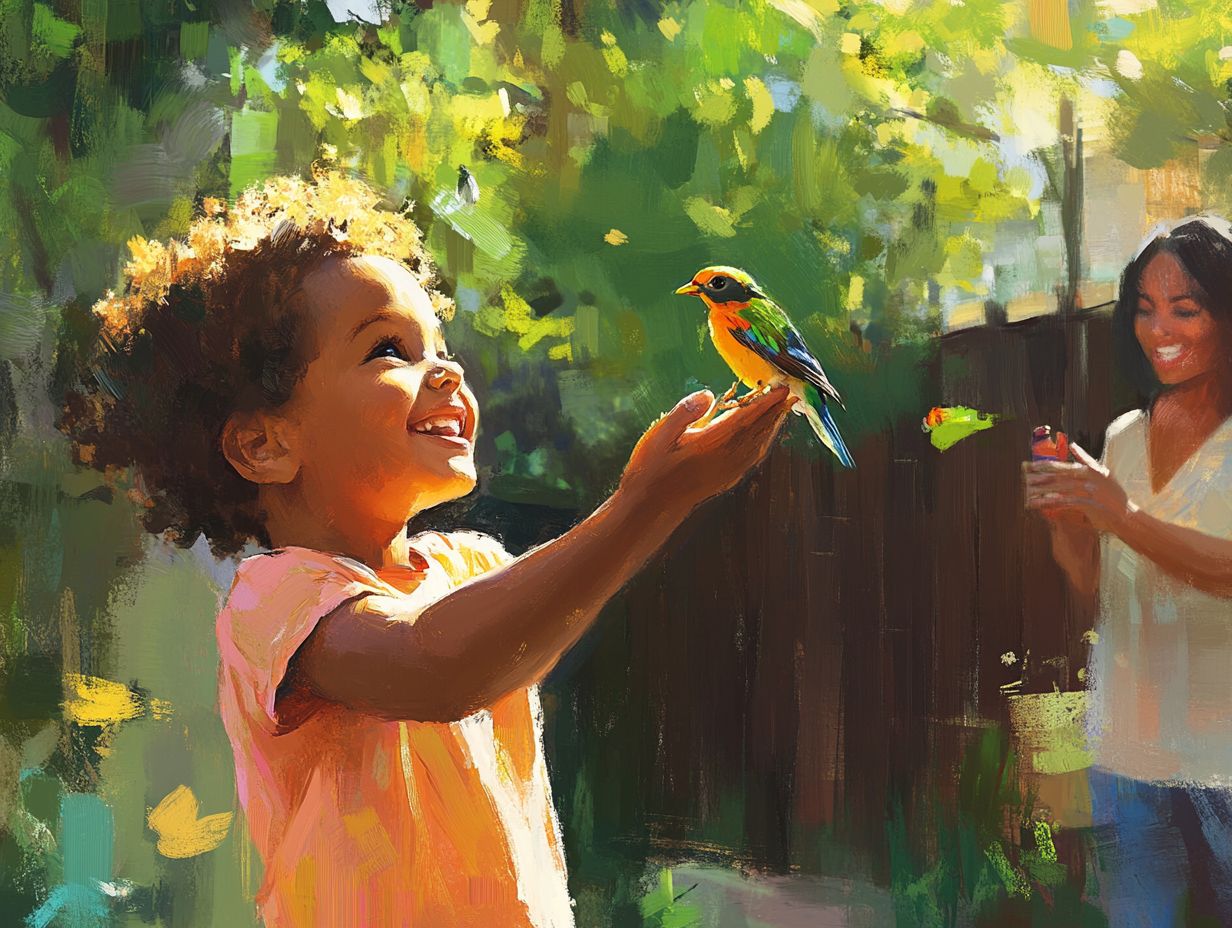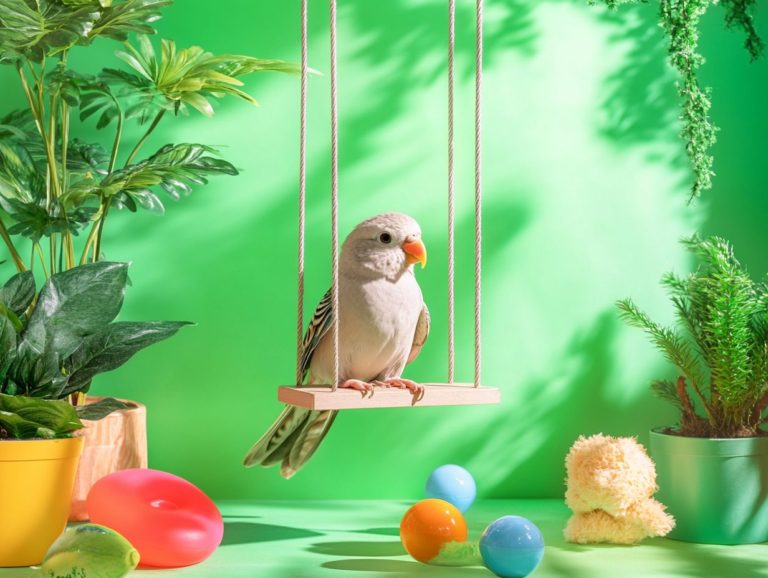How to Safely Introduce Birds to Children?
Introducing a bird to your child can be an enriching experience. It helps kids learn to care for others and fosters a sense of connection and responsibility that lasts a lifetime.
Let s explore the wonderful benefits of having a bird as a pet! This article provides guidance on selecting the perfect bird for your family and creating a safe, nurturing environment for both your child and the pet.
From a detailed introduction to step-by-step instructions on teaching your kids how to care for their new companion, this article equips you with essential insights for fostering a successful and meaningful bonding experience.
Contents
- Quick Tips:
- Benefits of Introducing Birds to Children
- Choosing the Right Bird for Children
- Let s Make a Bird-Friendly Haven!
- Introducing the Bird to Children
- Teaching Children to Care for Birds
- Frequently Asked Questions
- What are some important things to consider when introducing birds to children?
- How can I safely introduce birds to my child?
- Is it necessary to supervise interactions between children and birds?
- What are some signs that a bird may not be comfortable around children?
- What should I do if a child is scared of birds?
- Are there any safety precautions I should take when introducing birds to children?
Quick Tips:

- Birds help kids develop empathy and responsibility.
- When choosing a bird, consider its size, temperament, and care needs for a safe and enjoyable experience.
- Prepare a comfortable environment, like a properly sized cage with toys and perches, to help the bird feel at home.
Benefits of Introducing Birds to Children
Introducing birds to children presents an array of benefits that enrich their emotional and cognitive development. As they immerse themselves in nature’s diverse wildlife, children develop empathy and compassion for these fascinating creatures.
In California, the vibrant variety of coastal birds elevates this experience. Engaging with these birds helps children build emotional resilience.
This ongoing engagement nurtures their curiosity and teaches essential lessons about stewardship and respect for animals. It transforms their exploration into a rewarding adventure, connecting them harmoniously with the natural beauty around them.
Developmental and Emotional Benefits
Birdwatching offers a remarkable opportunity to enhance emotional resilience and developmental skills in children. It invites them to engage with their surroundings mindfully.
As young explorers observe birds in their natural habitats, they improve their observational skills. They start to notice intricate details like feather patterns and behaviors. This activity sharpens their focus and nurtures emotional intelligence, as children empathize with the creatures they encounter, gaining insights into their roles within the ecosystem an environment where animals and plants live together.
Educational programs that incorporate birdwatching encourage a compassionate approach. They help cultivate lasting appreciation for wildlife, instilling values of conservation and respect while forging meaningful connections with the environment.
Choosing the Right Bird for Children
Choosing the right bird for children is crucial for creating engaging and educational birdwatching experiences. Focus on species that are both child-friendly and easily observable in your backyard or local parks.
Factors to Consider

When selecting a bird, consider its temperament, size, and ease of observation. These factors significantly shape the child’s emotional bond with the animal.
The bird’s captivating behaviors, such as nesting or foraging, create enriching experiences as children learn to recognize different species through unique traits like song patterns and feeding habits. These activities not only capture their attention but also provide valuable opportunities for hands-on learning.
Encouraging children to engage in birdwatching nurtures appreciation for nature, sharpens observation skills, and sparks curiosity. Simple strategies like maintaining a quiet demeanor and using binoculars for a closer view can elevate their experience.
This combination of engagement and education fosters a deeper understanding and admiration for the avian world, creating lasting memories and connections.
Let s Make a Bird-Friendly Haven!
A bird-friendly garden designed with safety in mind can truly elevate the joy of introducing birds to children, encouraging outdoor exploration while ensuring the well-being of both the birds and the young observers.
To craft such an inviting space, you can take practical steps by planting native vegetation that serves as a natural food source and shelter essential for local bird species. Installing bird feeders filled with seeds or suet will attract a delightful variety of feathered friends, infusing your outdoor playtime with excitement and education!
Creating safe spaces for birds like limiting outdoor cat access and establishing brush piles for shelter enables them to thrive without fear. Wildlife rehabilitation centers educate families on the benefits of bird-friendly habitats. This helps nurture a sense of environmental stewardship that can be passed down through generations.
Introducing the Bird to Children
Introducing a bird to children involves simple steps that make it safe and fun, prioritizing both safety and enjoyment. By doing so, you can create a positive experience that nurtures their curiosity and deepens their understanding of the natural world.
Step-by-Step Guide
The step-by-step guide to introducing birds to children involves planning engaging birding adventures, teaching them to observe bird behaviors, and nurturing a genuine sense of compassion for all living beings.
To start, selecting the perfect location is essential; think about parks, wetlands, or nature reserves renowned for their diverse bird species. Equip the children with binoculars and a field guide a book that helps identify different bird species to transform the experience into something interactive.
During your outings, encourage them to track bird movements, making note of unique traits or calls, while sparking discussions about what these behaviors might signify.
Incorporate activities like crafting bird feeders to help them grasp the importance of nurturing wildlife. Weaving in storytelling about birds and their habitats can further foster empathy, making the learning experience both memorable and enjoyable.
Teaching Children to Care for Birds

Teaching children to care for birds means instilling in them a sense of responsibility and valuable lessons that foster empathy and compassion qualities that are crucial for cultivating responsible stewards of wildlife.
Responsibilities and Lessons
The responsibilities and lessons learned from caring for birds, like maintaining bird feeders and participating in community programs, truly foster emotional resilience and nurture instincts to respect and protect wildlife.
By engaging in these meaningful activities, you not only acquire practical skills but also cultivate a sense of responsibility and empathy for living creatures. Observing bird behavior offers you an opportunity to develop patience and attentiveness, inviting you to appreciate the intricacies of life surrounding you. Collaborating on wildlife conservation initiatives enhances your sense of teamwork and community, reinforcing the notion that collective efforts are vital for protecting the environment.
These hands-on experiences not only enhance your emotional growth but also forge a profound, lasting connection with nature, enriching your childhood and shaping your values for years to come. Act now to instill a love for nature that will last a lifetime!
Frequently Asked Questions
What are some important things to consider when introducing birds to children?
It’s important to make sure the birds are well-socialized and comfortable around children, and that the children are taught how to properly handle and interact with the birds.
How can I safely introduce birds to my child?

Start by having the children observe the birds from a distance, and gradually move closer as the birds become more comfortable. Let the children offer treats and toys to the birds to build trust.
Is it necessary to supervise interactions between children and birds?
Yes, always supervise interactions between children and birds to ensure the safety of both. Teach children to handle birds gently and avoid rough play.
What are some signs that a bird may not be comfortable around children?
Wondering how to tell if a bird is scared? If a bird shows fear or aggression like flapping its wings, squawking loudly, or trying to bite or fly away it might not be ready to interact with children.
Give the bird space right away to help it feel safe!
What should I do if a child is scared of birds?
If a child is afraid of birds, respect their feelings. Don’t force them to interact! Instead, slowly introduce them to birds in a calm environment. Let them observe from a safe distance until they feel comfortable.
Are there any safety precautions I should take when introducing birds to children?
Be sure to clip the birds’ wings to prevent them from flying away or escaping. Also, keep small children away from the birds’ cage to avoid accidents or injuries.






